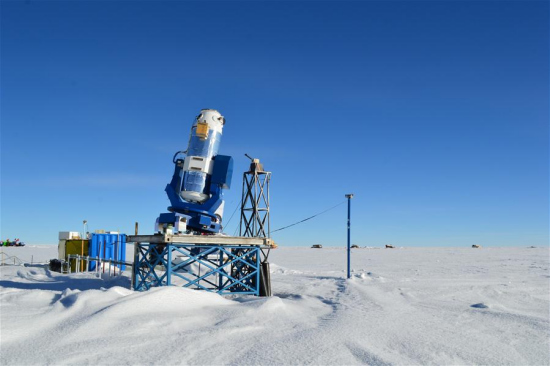
Photo taken on Dec. 30, 2016 shows Chinese telescope AST3-2. (Xinhua/Chinese Center for Antarctic Astronomy)
From gravitational waves seen in neutron star collision to life-saving gene therapy, the year of 2017 has seen major science breakthroughs, trends and events that will potentially shape the future of human life.
Following are ten science events, which have major impact on the world in 2017, and for many years to come.
GRAVITATIONAL WAVES USHER IN NEW ERA FOR ASTRONOMY
On Aug. 17, scientists detected gravitational waves -- the ripples in space and time, and light from the collision of two neutron stars. It was the first time a cosmic event has been "seen" from Earth in both gravitational waves and in light. In other words, the event helps to bring together traditional light-based astronomy with gravitational wave astronomy for the first time.
"I think this is a really major discovery in the history of astronomy," David Reitze, executive director of U.S.-based Laser Interferometer Gravitational-Wave Observatory (LIGO), told Xinhua in an interview shortly after he announced the discovery.
Gravitational waves were originally predicted in the early 20th century by Albert Einstein, but they were only detected for the first time by LIGO in 2015, a discovery that was awarded the Nobel Prize in Physics this year.
LIFE-SAVING GENE THERAPY WITH HEFTY PRICE TAGS
Decades of research on gene therapy is finally paying off. The U.S. Food and Drug Administration (FDA) approved not one but three life-saving gene therapy products this year.
The first, called Kymriah, was approved in August for certain pediatric and young adult patients with a form of acute lymphoblastic leukemia. Kymriah, known as "a living drug," uses a patient's own immune system cells, called T cells, after these cells have been modified to better recognize and kill the patient's cancer. The one-time drug is now priced at 475,000 U.S. dollars.
Two months later, the U.S. FDA endorsed Yescarta, a similar gene therapy, to treat adult patients with certain types of large B-cell lymphoma. The initial list price of Yescarta, also a one-time treatment, is similarly expensive at 373,000 dollars.
Then in December, the regulator green lighted a gene therapy called Luxturna to treat patients with a rare inherited form of vision loss that may result in blindness. The treatment delivers a normal copy of the mutated gene directly to retinal cells, leading them to produce a key protein that converts light to an electrical signal in the retina to restore patient's vision loss. Luxturna reportedly has a possible price tag of as high as one million dollars.
"I believe gene therapy will become a mainstay in treating, and maybe curing, many of our most devastating and intractable illnesses," FDA Commissioner Scott Gottlieb said in announcing the approval of Luxturna. "We're at a turning point when it comes to this novel form of therapy."
CRISPR GENE EDITING SPEEDS INTO CLINIC AMID ETHICS DEBATE
The revolutionary gene-editing technology CRISPR is moving rapidly into the clinic, with a report from the U.S. National Academies of Sciences, Engineering and Medicine recommending in February that clinical trials for gene editing of a human embryo "could be permitted in the future, but only for serious conditions under stringent oversight."
This year, scientists using the five-year-old tool have made advances in fighting diseases, antibiotic-resistant bacteria, mosquitoes and much more. For example, researchers from the Temple University made the first successful attempt to use CRISPR to remove HIV from a living organism. In August, a team at the Oregon Health and Science University reported the first known attempt at creating genetically modified human embryos in the United States.
Meanwhile, major improvements have been made in the technology itself. The newly-developed systems are now able to target the smallest units of our DNA or RNA, and Chinese researchers demonstrated the power of the so-called base editing by fixing a disease-causing point mutation in human embryos.
Scientists have also made breakthroughs in their quests for solutions for the worldwide shortage of transplant organs. In January, U.S. researchers announced they have used CRISPR to successfully create the first human-pig chimera embryos, bringing us a step closer to growing human organs inside pigs. In August, researchers from the U.S., China and Denmark reported that they have edited the pig genome to deactivate a family of retroviruses in order to create piglets that can't pass the viruses on to transplant recipients.


















































